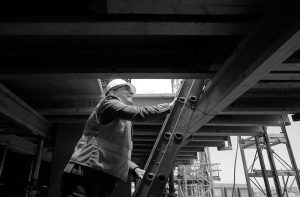A Blog by Andy McMahon, Senior Vice President, Policy & External Affairs, CSH
The word “infrastructure” normally conjures up thoughts of bricks and mortar. Investments like highways, pipelines, hospitals, schools and affordable housing development. But people, all of us, are infrastructure too. And when we examine the high return on investment (ROI) our nation receives from federal investments in affordable supportive housing — funding through Housing Choice Vouchers, McKinney-Vento, HOME and Low Income Housing Tax Credits (LIHTC) — we cannot overlook benefits that are not measured in numbers of buildings or units, but are instead gauged by human growth and progress.
highways, pipelines, hospitals, schools and affordable housing development. But people, all of us, are infrastructure too. And when we examine the high return on investment (ROI) our nation receives from federal investments in affordable supportive housing — funding through Housing Choice Vouchers, McKinney-Vento, HOME and Low Income Housing Tax Credits (LIHTC) — we cannot overlook benefits that are not measured in numbers of buildings or units, but are instead gauged by human growth and progress.
It is common to convey the impact of bricks and mortar. For example, respected experts tell us that for every 1,000 rental homes financed by the LIHTC: 1,130 jobs are created; $107 million in local wage and business income materializes: and $42 million in tax revenues fill our public coffers. Evidence suggests these economic impacts stay in the communities where LIHTC-supported housing is built, contributing to higher property values in surrounding neighborhoods and quality-of-life bonuses such as reduced crime rates.
In addition to the new and much-needed housing and overwhelming economic boosts fostered by these investments, there are human faces and stories that are just as impressive. Our role as national leaders in supportive housing gives us unique perspective into how federal housing programs change the trajectory of lives.
The creation and expansion of supportive housing (affordable rentals + access to support services) depends greatly on the Housing Choice Vouchers, HOME, LIHTC and other federal investments. In a report released last year, we noted that virtually every housing credit agency in the country fosters some form of supportive housing development through its federal housing credit programs.
In supportive housing, affordable housing is the platform of stability that allows very vulnerable people to focus on the complex challenges that are holding them back. Obstacles such as poverty, undiagnosed or untreated mental illness, chronic medical problems, serious addictions, family instability, limited employment skills or education, are very real barriers. Once people know they can afford housing and make a home for themselves, they do not devote their full energy to basic survival – where to sleep, eat, and bathe. They gain the flexibility and confidence to address long-neglected needs and receive the help that improves their health and well-being.
Although perhaps not as widely known, plenty of experts back these assertions up too.
Housing is now recognized as a social determinant of health, which means a person who is housed is likely to be healthier than one who is not (e.g., homeless, couch surfing, in shelter).
Because of our work in supportive housing, we have seen the stark differences that emerge once very vulnerable individuals are housed, and how treating the whole person significantly improves medical and behavioral health. As authors of some of the earliest papers and reports on this relationship, we used these observations to set the trend to promote stronger partnerships between healthcare and housing providers.
Through our interactions with health systems and clinical centers throughout the nation, we have been able to show how housing linked to healthcare reduces an over-reliance on crisis and emergency room care, thereby lowering costs.
The obvious benefits go way beyond better health and cost outcomes. An individual who has conquered an illness or addiction is more likely to thrive and take advantage of employment training and job opportunities.
One such person is Jeromy, who called a highway underpass home for ten years. He was well known to local hospital staff and emergency responders because Jeromy received crisis and emergency room care 59 times in one year!
One tragic day, intoxicated and high, he wondered from the side of the road into traffic and was hit by an oncoming car. He spent two months recovering in a hospital and two weeks of that extended stay laying in a coma. The costs associated with his healthcare were astronomical.
Fortunately, after leaving the hospital, Jeromy was introduced to supportive housing financed by federal investments and his life changed almost immediately. He went into recovery from his addictions. He found a part-time job and Jeromy’s short visits to clinics now average just 2 – 3 times per year.
There are thousands like Jeromy, “infrastructure investments” with high ROI because federal commitments to affordable supportive housing helped create their new lives. As we point to the units and jobs and revenues generated, let’s not forget the individual success stories behind those numbers and how all of our infrastructure (including people) improves because of them.
